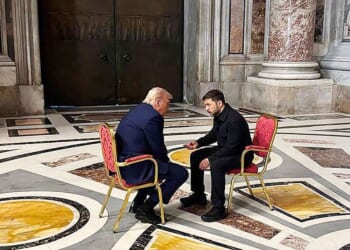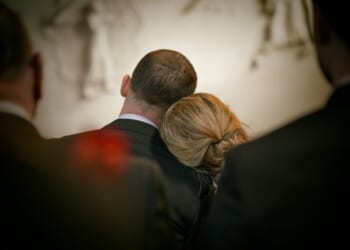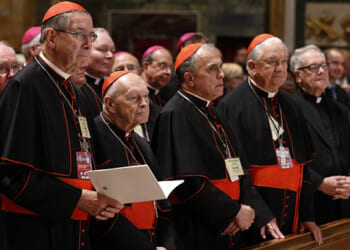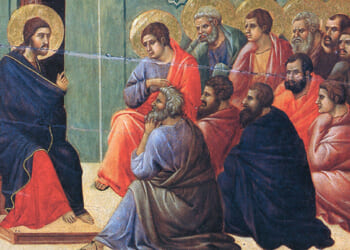Did Orpheus wear chartreuse? When Aubree Oliverson, wearing a vivid yellow-green dress, performed Antonio Vivaldi’s Violin Concerto in E Minor (RV 278) in Kontrapunktus’s program “Il Nuovo Orfeo,” she did not evoke a lonely musician wandering through the woods in mourning. What a violinist wears usually means little to a performance, but her dress became a kind of mood made visible. Hers was a Vivaldi of untethered play and sprezzatura. She had no trace of self-consciousness or reserve, nothing to invoke the Orpheus that “wandered the high mountains of Rhodope, and chill Haemus,” grieving and alone.
It is notable, though, that both Vivaldi and Ovid—the author of the most enduring account of the Orpheus story—were born in what is now modern Italy and spent time in Rome. Oliverson’s performance with Kontrapunktus, in late March at St. Andrew’s Catholic Church in Pasadena, was an exceptional Italianate take on Vivaldi. To understand how she inhabited the music, it’s worth considering the two dominant regional styles of the era: the Italian and the French. In the early years of the Baroque, the mathematician and music theorist Marin Mersenne wrote of the passion he heard in Italian music, as did the historian François Raguenet. French music, said Mersenne, was “sweet” and “caressed the ears.” But to Raguenet, “the Italians venture at everything harsh and out of the way.” These portrayals come from two partisan Frenchmen, but they tell us something about Vivaldi’s music, as well as Oliverson’s performance. Each put passion before sweetness.
Both Vivaldi and Oliverson thrive in dramatic contrasts. When she played softly, she skirted the inaudible. Her fortes were not just strong but formidable. She would sacrifice a sweet tone to expressiveness, even careening at moments into a sound Raguenet may have thought “harsh.” Her continuous vibrato revealed her taste more than Vivaldi’s, but the interpretation was compelling. Her evident joy—a trait indispensable to a performer—was catching. She is both an entertainer and an artist, neither diminishing the other.
The early music ensemble Kontrapunktus devoted “Il Nuovo Orfeo” to composers influenced by Arcangelo Corelli, including works by Leclair, Handel, Geminiani, Barrière, and Vivaldi. According to the program booklet, Corelli was known by his contemporaries as “The New Orpheus.” And this aptly describes Corelli early in the eighteenth century. His music and violin-playing shaped the composers who followed him. He helped establish tonal music—the minor- and major-key system we still use today—and we can trace how later musicians treat harmony back to his accomplishments in the early eighteenth century. He was also the first composer famous over the European continent for purely instrumental music. Corelli never wrote for the voice, but he still became Rome’s Orfeo.
Kontrapunktus began the concert with Corelli’s Concerto Grosso in D Major, Op. 6, No. 4. It is among his most popular works. Cameron Alan-Lee, the concertmaster, played his concertino part with precision and ease. He, like Oliverson, is an engaging performer and true to the period’s style. For example, he reserved his vibrato to match his other ornaments. Although we expect its constant trembling presence in music written from the nineteenth century onward, it can be distracting in Bach or Biber. Alan-Lee accordingly restrained his contrasts. One strength of the ensemble was their thoughtful phrasing: at no moment was the performance indecisive or lacking focus. Each musical choice felt natural, even inevitable.
Following Corelli, Jean-Marie Leclair’s Sonata in E Minor, Op. 3, No. 5, was a high point in the program. Leclair was the first important violinist of the French school. He was familiar with Corelli and had studied with one of Corelli’s star pupils, G. B. Somis. Leclair wrote his sonata for two violins, an uncommon pairing for the time. It begins with the violins echoing one another in quick passages that, without a harpsichord or violone to ground them, sound sylphlike and fluttering. Cameron Alan-Lee and Helen Yu played the piece gracefully. It is a delicate work, though. The sonata demands precise rhythms, or the texture will blur and lose structure. They kept it under control, despite a few slight missteps.
In the program’s second half, the ensemble performed an unusual piece by Jean-Baptiste Barrière, an early adopter of cello in France. The instrument came to replace the viola da gamba, which he had likely studied before settling on the cello. His Cello Sonata in B Minor, Book 1, No. 1, is the opposite in spirit to Leclair’s sonata. Rather than sounding sprightly, Osheen Manukyan’s cello and Nicholas Arredondo’s bass were opaque and rich, overwhelming Keika Mori’s fragile harpsichord. This sonata was Barrière’s first for the instrument, and it seems inspired by the more lithe, transparent-sounding viola da gamba. Perhaps Barrière expected a more substantial continuo accompaniment to balance the cello’s weight, or he was used to the viola da gamba’s easy double stops and slight sound. It is an attractive work, but the performance suffered from imbalance. Manukyan’s playing was virtuosic, though he had a few problems with intonation and continuity.
The Orpheus myth is perennial, but it had particular resonance in the age of Corelli. Among the first operas was L’Orfeo, composed by another Italian, Monteverdi, at the birth of the Baroque era. And the subject wasn’t only popular among musicians. Rubens, Savery, and Poussin all rendered Orpheus in paint. To call Corelli “Orfeo” was to allude to a story well-known to the literate classes; it was a bit of flattery that was recognizable all over Europe. But if Corelli was “The New Orpheus,” his music—and the music of those who followed him—was that of Orpheus on his wedding day: full of promise and hope. It was not yet the music of a solitary Orpheus trying to rescue his wife from the underworld. This was a living music, improvisatory and spirited. It may not summon trees, rivers, and stones, but as Kontrapunktus reminds us, it still charms.
















